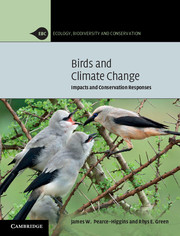Book contents
- Frontmatter
- Dedication
- Contents
- Foreword
- Acknowledgements
- 1 Birds and climate change
- Part I Impacts
- Part II Conservation responses
- 6 Using models to predict the effects of climate change on birds
- 7 Conservation in a changing climate
- 8 Effects of climate change mitigation on birds
- 9 Overall conclusions
- References
- Index
9 - Overall conclusions
Published online by Cambridge University Press: 05 June 2014
- Frontmatter
- Dedication
- Contents
- Foreword
- Acknowledgements
- 1 Birds and climate change
- Part I Impacts
- Part II Conservation responses
- 6 Using models to predict the effects of climate change on birds
- 7 Conservation in a changing climate
- 8 Effects of climate change mitigation on birds
- 9 Overall conclusions
- References
- Index
Summary
Impacts of recent climate change
In the first part of the book, we examined the impacts of climate change on bird populations. We found good evidence that significant changes have occurred in the timing of seasonal events within the annual cycle of birds (Chapter 2). In recent decades, both spring arrival of migratory species and egg-laying dates, as measured for the average individual in a population, have advanced consistently by some 2 days per decade across temperate and boreal latitudes. Phenological changes affecting the timing of the end of the breeding season, and autumn departure dates of migrants have varied much more between species, depending on migration, moult and breeding strategies. A wide range of correlative analyses, supported by a small number of studies of underlying mechanisms, have demonstrated that many of these changes are a consequence of warming. Recent climate change has therefore altered the seasonal pattern of avian life cycles. Although there is currently insufficient monitoring of birds in tropical areas to track their long-term phenological responses to climate change, the studies which have been conducted suggest that here, changes in precipitation, and not temperature, are likely to be the main determinant of the timing of commencement of the breeding season and the movement of individuals. Trends in tropical bird phenology are therefore likely to be related primarily to changes in rainfall patterns.
- Type
- Chapter
- Information
- Birds and Climate ChangeImpacts and Conservation Responses, pp. 359 - 382Publisher: Cambridge University PressPrint publication year: 2014



